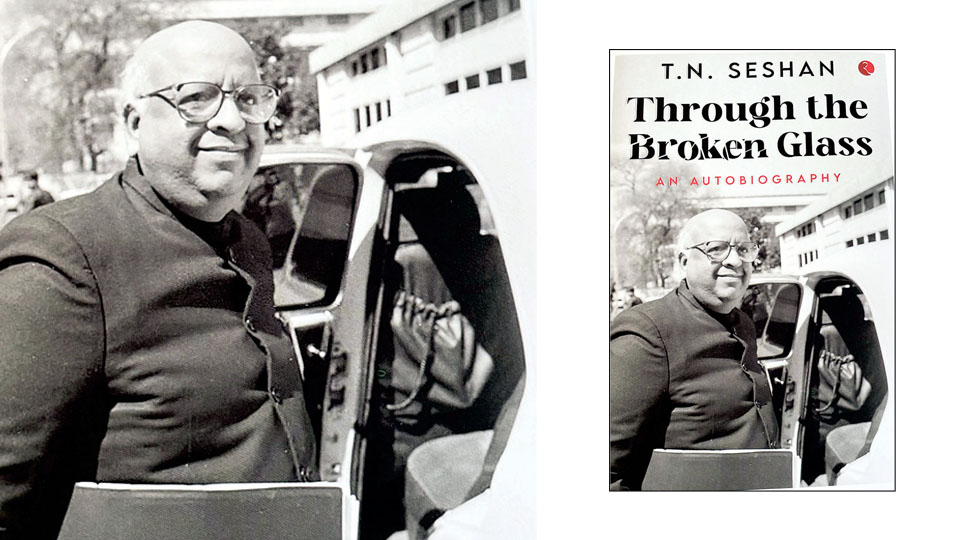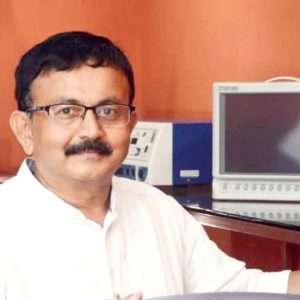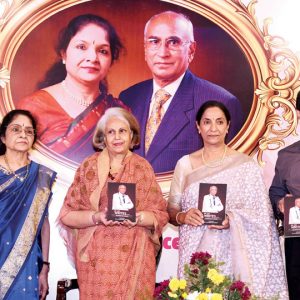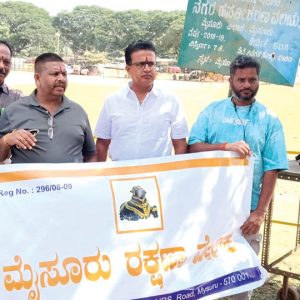By R. Chandra Prakash
Title: Through The Broken Glass-An Autobiography
Author: T.N. Seshan
Year: 2023
Pages: 350+
Price: Rs. 795
Publisher: Rupa Publications Pvt. Ltd., New Delhi
[Continued from Dec.20]
T.N. Seshan was aware that elections had become a symbol of corruption. He records, “The practices and traditions of hol-ding and con-ducting elections were going down the wrong way; it had to stop somewhere, the Republic had to fight back.”
Seshan was conscious of the fact that as Chief Election Commissioner (CEC) he was answerable to none except the Parliament, the Laws, the Courts and that he had to abide by the Constitution if he were to pursue the goal of executing free and fair elections. Therefore, within a day after his taking over as CEC Seshan in his press briefing had said, “And a lot more needs to be done in almost every sphere of the electoral process, including the electoral rolls, polling stations, code of conduct and the role of civil servants and the polling personnel to make the elections foolproof.”
Cleaning the rot within
However, when Seshan visited the Election Commission of India (ECI) Office for the first time after taking over as CEC, the realisation dawned on him that he had to start the election transformation process first from within, because of ‘the easy-going atmosphere, the stinking toilets and the broken furniture told him that a lot needed to be done first at the ECI itself! ECI had got inflicted by the overall work atmosphere prevailing in the country at that time.’
He was surprised to note that there was huge ‘overtime’ bill. He records, “I was more than certain that the amount of work done in the ECI did not require so much time that the staff need to do overtime. The overtime bill of the Commission dropped drastically from Rs.7 lakh to less than Rs.1 lakh per month after I took over. Similarly, the surprise checks helped in improving the general discipline. The house-keeping helped in sprucing up the work environment… A major bank had a branch in the premises of the Commission and it had accounts of all kinds of people not connected with the Commission. The fact that many people not connected with the Commission were visiting the body’s premises was not acceptable, as it undermined the Office’s discipline. Soon, in the place of that bank, another major bank set up a branch to serve the Commission and to its employees exclusively.”
The ECI uses the lent services of the selected local Government employees for a short period to carry out the gigantic task of conducting free and fair election. Till Seshan took over as CEC such borrowed staff hardly knew their full responsibilities or were hand-in-glove with local bosses, both political and others, or some did not hesitate even to refuse to accept these electoral duties. In a nutshell, the Commission was hamstrung in performing its duties effectively. Seshan had to use all his experience of a successful bureaucrat in converting such recalcitrant group of Government employees into a battle ready ECI army!
His autobiography is replete with examples of how he tamed unruly officials and trained them to be an effective election army. Within a short time, ECI started to make impact on electoral scenario of the country under his leadership. And politicians and political parties started to feel the unprecedented heat. That set in motion a campaign against Seshan the CEC!
Reforms and Repercussions
Seshan was very clear that “The responsibility of CEC is not only to run the electoral process efficiently but also to identify and implement ways and means by which the electoral process would improve.” Since the State Governments were used to bulldoze their agendas during the elections, every step Seshan took led to confrontations and cases in various courts challenging the authority of the ECI. He realised that “The executive was trying to bully the ECI into a subservient position in relation to elections.”
Seshan recollects, “I had been cautioning the Government with two alternatives open to me: that I would stop all election processes; and two, that I would take the matter to court with suitable jurisdiction to obtain a decision on the matter.”
Soon the Tamil Nadu election provided Seshan with the opportunity to strike, which he did. Expressing his inability to carry out his constitutional duties as CEC due to lack of co-operation from the executive he declared that he is compelled to postpone the elections. Since such action was unexpected from the ECI, all the hell broke loose.
During this very time, as if providential, the Supreme Court in its judgment on 19th August 1993, relating to the State of J&K, upheld the steps taken by the ECI to reform the poll process. Looking back, Seshan felt that ‘his electoral reforms, 2-19 August 1993, should be considered red-letter days in the history of the Commission. It was important because it clarified that the Constitutional scheme gave control to the ECI. Otherwise, free and fair elections would not have been possible.
‘Sarcar’ hits back
Earlier to T.N. Seshan’s arrival at the ECI, his predecessors did not seem to have a proper understanding of the scope of the ECI’s autonomy. The Govern-ments, rather the political power-centres, had become addicted to run the elections as per their whims. Therefore, the political power-groups prevailed upon the Government at the Centre to ‘clip his (Seshan’s ) wings.’ And within a short period of the Supreme Court’s autonomy judgment on 19th August 1993, the Sarcar hit back at the ECI .
On 1st October 1993, an Ordinance was passed appoi-nting additional two Election Commissioners at the ECI — G.V.G. Krishnamurty and Dr. M.S. Gill ! The Ordinance that enabled the appointment of the two Election Commissi-oners was called “The Chief Election Commissioner and Other Election Commissioners (Condition of Service) Ordi-nance. These appointments were justified by the Government on the ground of “to assist” Seshan in his work! Whereas Seshan himself felt that his workload at the ECI “took about 10 minutes in the morning and three minutes in the afternoon.” And the rest of any working day he was free of any demand from the ECI’s Office, he rather spent time ‘solving The Times of India crossword.’
Seshan fights it out
This new situation led to Seshan going to the Supreme Court to seek the equivalence of the CEC and the other Election Commissioners. On 15th November 1993, in its stay order on the Ordinance, the two-Judge Bench of the Supreme Court gave a relief to Seshan through its interim order by stating that: “…we direct that the Chief Election Commissioner shall remain in complete overall control of the Commission’s work…”
However, till the final deci-sion, which came only in 1995, he continued to provide the additional Commissioners necessary official facilities and involvement in the decision-making process at ECI. But the several unsavoury incidents narrated in the book reflect very badly on the behaviour of some people appointed to an autonomous body like the ECI. The deliberations in the court, summarised by Seshan in some details, make very interesting reading. It becomes quite obvious that the ECI had become a proxy for the politicians who wanted to keep the manipulating power in the election processes.
Despite pin-pricks from additional Commissioners, executive obstructions from Government and legal challe-nges from politicians and political parties, Seshan continued his 360 degree election reforms. He cleaned up the laid-back and casual attitude of the staff within ECI and set standards for immediate actions. He created an aura of autonomy and self-restrained functioning within ECI.
He inculcated discipline among the executive staff on deputation for election work, from DMs, Police force to the last official at the booth-level. The power of ECI to discipline the erring Officer on election duties, which was established by the Supreme Court order of 19th August 1993, was set in motion by penalising those who treated the ECI orders casually.
EPIC and a strong foundation
His pet project was the issue of EPIC — Election Photo Identity Card. This was the time when except for the Passport Indians did not have any individual Id cards. The cost-effective technology was not available and it was abhorred by the politicians and the parties as they feared a tight ECI control over the booths during the conduct of election. Entire abuse thus far at the booth- level, such as booth capturing, voter impersonation etc., would be impossible with EPIC! Later on EPIC became a game-changer in the election process. With the introduction of Aadhaar now every Indian has at least two valuable personal identity cards.
In the annals of Indian democratic process, Seshan’s contributions have become strong foundation. He single-handedly bulldozed every impediment that came his way, be it executive processes or legal hurdles, he faced them head-on with full courage, his administrative acumen and experiences with political class.
Prediction of post-1996 political scenario?!
The following quote sounds like Seshan had some premonition of things going to happen:
“My greatest agony was whatever changes I had made in the electoral process could be undone once I left the Office of the CEC. Whenever I had tried to get the Government to make systemic changes, I had met a stone wall. I almost thought this was done by the PM and his party deliberately. An indifferent successor could, in collusion with non-benign PM, take elections back to not only the joke they were, but even worse than they had been.” The demand from certain political parties to bring back ‘voter slips’ and to do away with EVMs is very much in tune with Seshan’s fears.
A concurrent history
Seshan was a very vibrant and dynamic personality. His biography reflects these qualities as also his intellectual sharpness. Looking back he felt his “Life has been great — stormy, but great.” Photographs of various stages in Seshan’s life enhance the utility of this autobiography. It is not only about his life, but is equally nation’s recorded concurrent history — a turbulent period of 1991-1996 which trans-formed the economic structure from planned economy to one of private sector driven one; and a period which challenged the very core political values of our democracy. However, no book review or for that matter not even an exhaustive autobiography itself, can do justice to the dynamic life of a Maverick that T.N. Seshan was.
[Concluded]








Recent Comments